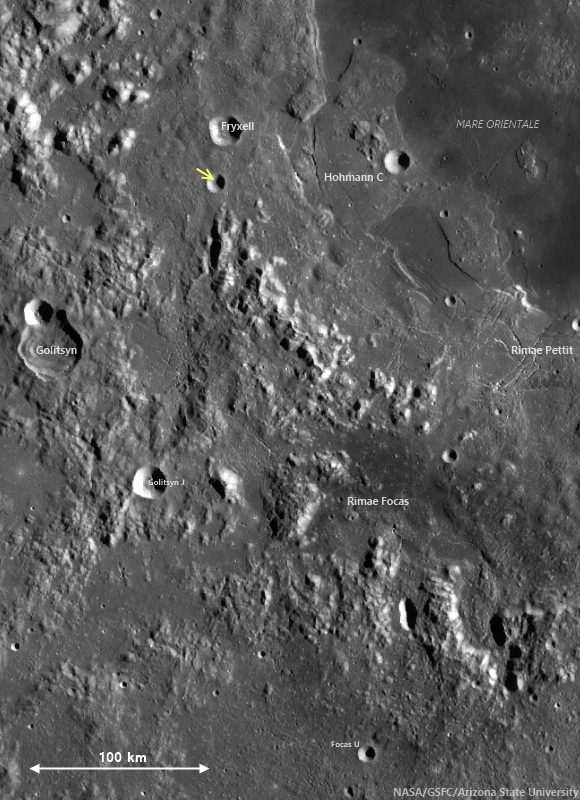 |
| Northwestern rim of an unnamed crater located on southwest edge of Orientale basin; 870 meter field of view centered on 22.110°S, 258.014°E, southeastern downslope to the lower-right. LROC Narrow Angle Camera (NAC) observation M184189330L, LRO orbit 12235, February 18, 2012; resolution 87 cm from 85.03 km, angle of incidence 37.04° [NASA/GSFC/Arizona State University]. |
Hiroyuki Sato
LROC News System
Today's Featured Image (Dec. 31, 2012) highlights an upper portion of the crater wall of an unnamed crater (10.7 km diameter), located in the southwest portion of the Orientale basin. The rim crest is at upper-left in this image. The biggest crater at the left side is actually on the rim crest.
The distinctive crack extending from the lower-left to upper-right cuts across a rough fractured slope. Most likely this surface corresponds to smoother terrain just outside the crater (upper left). Likely both surfaces formed as impact melt cooled. The portion on the steeper surface later fractured as gravity-driven slides slowly broke this crust.
Explore the sinuous cracks in the full NAC frame yourself, HERE.
Related Posts:
Steps in Slipher S
Veneer of Melt
Melt on a Rim
Impact melt outside Wiener F
Craggy Peak, Impact Melts
Slope failure near Aratus crater
LROC News System
Today's Featured Image (Dec. 31, 2012) highlights an upper portion of the crater wall of an unnamed crater (10.7 km diameter), located in the southwest portion of the Orientale basin. The rim crest is at upper-left in this image. The biggest crater at the left side is actually on the rim crest.
The distinctive crack extending from the lower-left to upper-right cuts across a rough fractured slope. Most likely this surface corresponds to smoother terrain just outside the crater (upper left). Likely both surfaces formed as impact melt cooled. The portion on the steeper surface later fractured as gravity-driven slides slowly broke this crust.
 |
| A wee bit more context (from the spectacularly upgraded LROC WMS Browser) reveals the sparse Fryxell crater group as nested in one of the more dramatic lunar landscapes, and the unnamed "crater of interest" itself (arrow) apparently directly atop one a buried portion of a Mare Orientale peak ring [NASA/GSFC/Arizona State University]. |
Explore the sinuous cracks in the full NAC frame yourself, HERE.
Related Posts:
Steps in Slipher S
Veneer of Melt
Melt on a Rim
Impact melt outside Wiener F
Craggy Peak, Impact Melts
Slope failure near Aratus crater




No comments:
Post a Comment